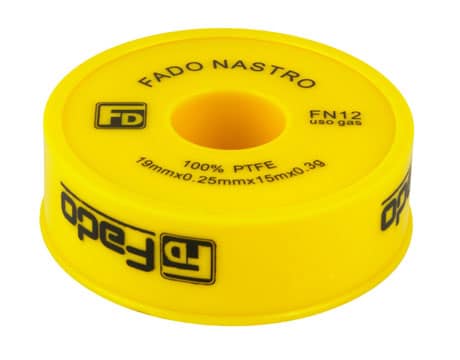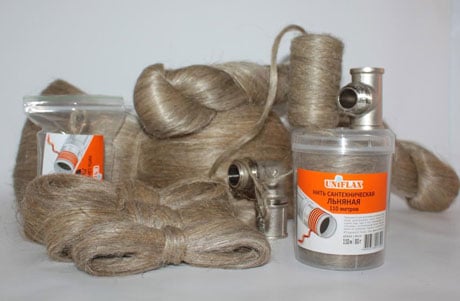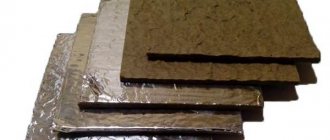Fum tape: what is it ↑
Plumbing tape: production and types ↑
PTFE sealing material, or fum tape for short, is a PTFE film used to seal pipe joints. It is made by rolling a fluoroplastic rope to the required thickness. The seal is produced in the form of a tape of a certain size, wound on a reel (by analogy with electrical tape). They are used for the installation of systems under pressure: water supply, gas supply, central heating. The material acts as a deformable filler and thread lubricant at the same time, which improves the sealing of joints.
Types of fum tapes:
- fum-1 - designed for sealing pipelines operating with aggressive media. Contains lubricant - refined petroleum jelly;
- fum-2 - used in systems in contact with strong oxidants, therefore it is not impregnated with grease;
- fum-3 - used in systems working with clean environments. Does not contain grease.
Fum plumbing tape also differs in size: thickness ranges from 0.075 to 0.25 mm; width starts from 10 mm; length from 1000 mm.
They produce a special yellow gas fum tape with a thickness of 0.15-0.25 mm. For gas pipes operating at low pressure, ordinary plumbing tape can be used.

Special gas fum tape is denser than ordinary plumbing tape
Technical characteristics and properties of fum tape ↑
Main properties of PTFE:
- Low coefficient of friction. Fluorinated plastic polymers (PTFE) have a very low coefficient of friction - they are slippery, which makes it easier to connect fittings. They act as a kind of pipe thread gasket, improving fit and sealing.
- Heat resistance. PTFE has an extremely high melting point for plastic - 327 degrees. They are designed for use at temperatures up to 260 degrees (they release toxic fluoride compounds when heated above). PTFE are excellent dielectrics (electrical insulators), which is an added plus.
- Plasticity and strength. Resistant to mechanical stress. They work at constant pressure up to 10 MPa, withstand drops up to 41 MPa. Average service life is 13 years. Prolonged exposure to light will slightly impair properties.
- Chemical and biological inertness. They are highly resistant to acids and alkalis. There is no solvent for PTFE yet. The polymers are, as it were, uniformly sheathed with fluorine atoms, which makes the material inert with respect to almost all chemicals. Decomposition is possible only under extreme conditions created in special laboratories. Not subject to decay.


The ductility of PTFE allows the plumbing tape to stretch and fit snugly around the thread
Gas pipes on fum tape
If you wish, you can find on sale a special fum tape, on the packaging of which it will be written that this is a packing material for gas pipes. It is clear that any company or even a private trader engaged in the manufacture of consumer goods for all occasions can write an advertisement that this fum tape is intended for gas. As a rule, there are no arguments in favor of the fact that the special fum tape is recognized and approved by the state authorities for use. In the best case, there is a link to GOST or TU.
Household gas remains too dangerous to test the purchased gas fum tape and even more so to test it on yourself.The opinions of numerous specialists of regional gas management departments on this issue strongly differ, but in practice, a locksmith uses fum tape when installing equipment. Regular FUM2, but of good quality.
Construction regulations 42.101-2003, paragraph 10-221, state that fum tapes can be used if the quality and performance of the PTFE packing material is confirmed by a certificate of conformity.
In reality, the joints of steel gas pipes assembled on a fum tape are rather weak. A thin fluoroplastic interlayer in a sleeve joint works well only for short pipes. Joints must be necessarily fixed with additional fasteners, excluding bending or kinking at the joint.


For knees and turns, cantilever overhangs of more than one and a half meters, instead of fum tape, new packing materials such as "Loctite" or traditional red-lead linen are used. And vice versa, it is quite possible to install transitional flexible hoses for connecting a gas stove and a water column on a high-quality fum tape.


Oaklya: what is it and how to work with it ↑
Before the appearance of fum tapes on the market, sanitary tow, which was flax fibers, was used to seal threaded pipe joints. Optimum results were achieved by smearing a layer of tow, wound on the threads, with a small amount of oil paint. Such a connection was difficult to make out after a few years.
Nowadays, sanitary flax in the form of long silky threads is used along with new sealing materials. Only now a layer of sealing paste is applied over the winding, which ensures a reliable and durable connection. The paste protects the flax from rotting, and if necessary, makes it easier to dismantle.


Flax fibers are long, thin, strong, fit tightly into the grooves of the thread and do not deform when wrapped
What is fum tape and what is it used for?
FUM tape, or fluoroplastic sealing material, is a thin synthetic seal produced in the form of a tape, usually having a translucent or matte white tint. Due to the content of fluorine, fum tape has a fairly high mechanical and thermal stability. It does not age, does not tear when stretched and does not lose its properties under the influence of aggressive chemical environment or high temperature.
The main purpose of the fum tape is to seal threaded, nipple and flange connections in process pipelines, cold and hot water supply networks and various engineering systems operating under a pressure not exceeding 9.8 MPa.
Fum tape is made by rolling out a bundle of fluoroplastic-4 and wound into rolls of various widths (from 10 to 16 mm). Depending on the brand, this product may also contain various types of lubricants. There are three main brands of fum tape:
- FUM 1: It is used for sealing general industrial pipelines or for systems operating with aggressive chemical media. It contains up to 20% vaseline oil as a lubricant;
- FUM 2: It is used in systems working with strong oxidants and does not contain lubricants;
- FUM 3: It is used for systems working with extremely clean media.
How to wind tow on a thread ↑
To prevent flax from slipping along the thread, notches are provided on it.
Please note: in the absence of factory notches, they should be applied independently, otherwise, when screwing on the fitting, the flax will run off the thread.


Impregnation of flax with a special paste, coupled with the correct winding - a guarantee that the connection will last a long time
For winding, a small strand of flax is separated. The length and thickness of the "strand" is determined visually depending on the diameter of the pipe.The winding is done as tightly as possible, the threads are guided along the thread, the free end of the tow is fixed with a finger, and after a couple of turns it is brought into the guide strand. The tightness of the connection is ensured by the optimal layer thickness. It is rather difficult to calculate the density: you need experience, a certain "plumbing" eye.
How to use the tape
The main difference between the tape and the use of flax is its ease of use. It is not necessary to have any special skills in working with the tape. But there are nuances that you definitely need to know about:
- The thread must be clean. If there is a coating of rust or threads cut off, then these causes must be eliminated by stripping and straightening. Otherwise, the tape will not be able to ensure tightness;
- The tape is wound only on the external thread in the direction of twisting. Keep in mind that there are connections with both right and left threads, and if wound incorrectly, the tape will not be able to ensure tightness;
- If the threaded connection is wider than the tape, then each turn must partially overlap the previous one. A large tape will not work for narrow threads, this must be borne in mind;
- When winding, it is necessary to slightly tighten the tape. It is important that the threads show through the tape. Do not be afraid that it will break, it is better to tighten it tightly than to wind it loosely;
- The number of layers should be quite large: for pipes of small diameter (15-25 mm), 7-10 layers are enough, from 25 to 40 mm - 12-15 layers, etc.
It is not possible to specify the exact number of layers, since the tape manufacturers have different thicknesses and widths. This is determined empirically: when screwing, the process should take place with little effort: if it is easy, the number of layers should be increased, if it is tight, it should be reduced.
- Do not forget about the end of the tape - it should not interfere with the process of winding the other connecting element. After winding, press the end tightly to the thread and glue it with a few strokes;
- Pre-count the number of revolutions of the connection - after winding the tape and tightening the nut, it is impossible to loosen the connection, because the tightness will be broken.
If you made a mistake with the tightening torque, then disassemble the connection, clean the thread from the remnants of the tape and wind the new one in several layers again, having previously memorized the required number of turns.
obustroeno.com
How to properly wind a fum tape on a thread ↑
The tape is wound around the external thread of the fitting. When repairing plumbing, the old connection must be cleaned of rust, dirt, and then degreased with a solvent. Winding is done only after drying. The main requirement: the fum tape should be tightened quite tightly so that it fills the grooves and fits snugly around the thread. Experienced plumbers say that tearing the tape is better than loose winding. The number of layers varies from 4-6 to 20-25 and depends on the thickness, width of the tape and the diameter of the pipe - the main thing is that the entire thread is hidden. Plumbing tape requires a little more than tow, since, unlike flax, it will shrink. When working with fittings Ø from 1 inch, it is more convenient to wind the entire width of the trench, making sure that it is pressed into the turns. After screwing the nut, the fibers of the fum tape break into threads that fill the interturn space - the seal remains in the thread and seals it.
Important: adjustment (adjustment) without loss of tightness is impossible - you cannot even slightly unscrew the twisted fitting.


Fum tape is quite elastic, therefore, with tight winding, the threads are clearly visible
Tutorial video: thread sealing with fum tape ↑
Working with modern seals requires certain skills. Therefore, it is better to entrust even the simple steps of replacing a mixer or connecting a flexible hose to a professional plumber. Then all connections will be sealed, and your nerves will be calm.
The use of a seal is mandatory when installing each pipeline.A gasket is needed in order to make various connections tight. Such connections are threaded, flanged, nipple.


Previously, traditional tow was used, this material was replaced by a film, which is fluorine-containing. This seal is called by different names, for example, fum thread, teflon, and so on. Let's discuss the technical description of this seal, its properties, the main pros and cons, comparison with other materials. We will also understand how to wind it. Consider the question: what to choose: flax or fum tape?
Which is better: tow or tape fum ↑
Each material has its own advantages and disadvantages. Plumbing flax is used to seal steel pipe joints (especially rusted and / or large diameter).
Advantages of tow:
- the ability to adjust the connection: unscrewing back by 45 degrees is permissible;
- reliable tightness: absorbs moisture well;
- resistance to mechanical stress;
- easy dismantling of the connection.
The disadvantage is a tendency to rotting / decomposition, since tow belongs to natural materials.
Plumbing tape is preferable to use on small diameter pipes, plastic pipes, in the case of thin-walled fittings. It is easier to work with fum tape, it takes less time for installation.
There is no single answer to the question: "Which is better - fum tape or sanitary flax". It all depends on the specific plumbing work. For example, it is more convenient to connect a kitchen faucet with a flexible hose using fum tape, and it is better to seal the fitting on the water pipe using tow.


Better compaction is achieved by winding a small amount of flax and then securing with several turns of tape.
Specifications
Consider the main technical characteristics of the fum tape:
- The main advantage of fum tape is its resistance to mechanical and thermal damage.
- Possesses a high level of plasticity.
- Over time, the tape does not lose its quality, does not harden, does not crack, does not peel off from the joints.
- The tape is resistant to aggressive chemicals.
- During operation, the material does not emit harmful substances into the environment, being completely safe for people.
- The material works in a wide temperature range, from -70 to +200 degrees. And such a high-temperature fum tape can ignite only at a temperature of about 520 degrees.
- The thickness of the tape is 0.1-0.14 mm.
- The elongation at break can be up to 100%.
Important: It is not recommended to heat the tape to high temperatures, since already starting from a temperature of 250-280 degrees, the material can begin to emit harmful fluorine compounds.


But you can also note some of the disadvantages of the sealing material:
- A sufficient level of sealing is not ensured when using tape for large diameter pipes;
- It is possible that the tightness is broken in the event of temperature differences, as a result of which the material expands;
- If the connection is vibrated or in motion, a sufficient seal may not be obtained.
Anaerobic gel sealants: santechgel ↑
Another modern material for sealing pipe threads is santechgel. Reliable sealing is due to the polymer component of the gel. After hardening, sanitary gel does not shrink or expand, is resistant to temperature extremes (from -60 to +150) and pressure surges, has proven itself in various environments: water, natural and liquefied gas, heating antifreezes.


How to seal the plumbing connection: flax, fum tape, anaerobic sealant - the specialist decides
Santekhgel is produced in three types:
- In green tubes - easy dismantling.
- In blue - medium dismantling.
- In red (Stop Master Gel) - heated dismantling.
Installation using sanitary gel is simple: shake the tube and apply the gel in a thick layer along the entire circumference of the thread, distribute it evenly (with a brush, a special spatula), and assemble the structure. Remove excess gel with a cloth. Gel polymerization takes 15–20 minutes.
Important: plumbing gel should only be applied to a clean, grease-free surface.
Santehgel
Sanitary gel sealant is a modern tool for sealing pipe threads. Reliability is ensured due to the fact that this material contains polymers. Once a given substance is solid, no shrinkage or expansion occurs.
Santekhgel has a high level of stability and can withstand sudden changes in temperature. Pressure surges are also not terrible for this product. Santechgel can be used in a variety of applications: for gas, for water, and so on.
In total, there are three types of sanitary gel:
- Material that can be easily dismantled. It is sold in a tube that is green;
- plumbing gel for medium dismantling is sold in blue tubes;
- dismantling with heating is typical for the material that is sold in red tubes.
Installation using plumbing gel
First you need to shake the tube. Further, a layer of sanitary gel must be applied along the entire circumference of the thread. The layer must be thick. Spread the gel sealant evenly. This can be done with a brush or a specially designed spackle.
At the end, the entire structure is assembled. Polymerization takes 20 minutes. Remember to degrease the surface. Santechgel is better than fum tape. This product is suitable for pipes regardless of what they are intended for.
To work with gaskets, you must have some experience and knowledge. Therefore, it is recommended to entrust the work to real specialists, regardless of what you use: linen threads or fum material. They know how to rewind fum correctly and will do the reeling in a quality manner. Then the joint is sealed. This product is suitable for hot water and gas.
teplota.guru











